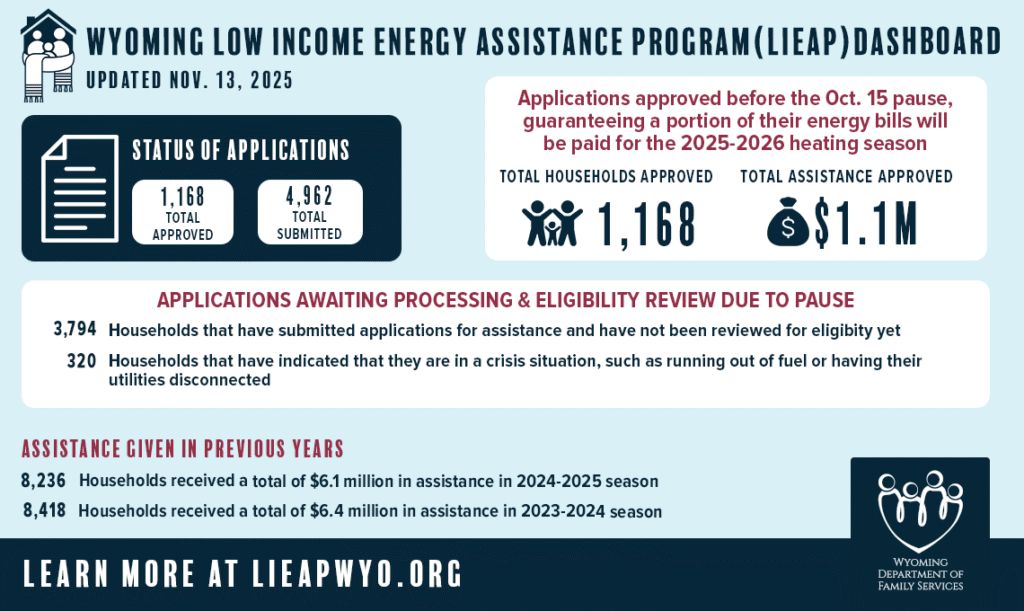
The Wyoming Low Income Energy Assistance Program (LIEAP) helps eligible Wyoming households by paying a portion of their winter home heating costs, assisting with heating emergencies, and improving home energy efficiency. Priority is given to households with seniors aged 60 and over, families with children 5 and under, and individuals with disabilities. The LIEAP team is available to answer questions. The phone number for LIEAP is (800) 246-4221 or email lieapinfo@wyo.gov.
LIEAP funding secured: Application Processing and Payment Flow
[Update as of Dec. 5, 2025] The Wyoming Low Income Energy Assistance Program (LIEAP) has successfully received its funding for the 2025-2026 heating season. As a result, we have immediately resumed processing and reviewing for approval all pending applications. Our team is working diligently to review and finalize these as quickly as possible.
Application Review Process
We are moving quickly to approve eligible applications. To avoid processing delays, households should log in to the application portal at lieapwyo.org to confirm their application has been submitted, view their application status, and address outstanding requests for information. It is essential to complete the entire application, answer all questions, and attach all requested documentation. Failure to do so will result in delays, as LIEAP must issue a request letter for the missing information, which extends processing times. For those unable to access the online application portal, the phone number for LIEAP is (800) 246-4221.
Notification of Benefit Decision
LIEAP will notify households by email or letter when their application has been processed. This notification will indicate status, the benefit amount, and the utility or vendor receiving the payment. Payments are made directly to the primary heating fuel vendor (e.g., gas, electric, propane company), not to households. If a household is eligible, LIEAP pays a portion of the primary heating source monthly until the seasonal benefit is exhausted or through May 30, 2026, whichever comes first.
Understanding Benefit Payment Timeline
Please be aware of the necessary steps required before the benefit payment can be made to fuel or utility providers:
- Application Approval & Notification: Once a LIEAP application is approved for benefits, we will notify the household’s designated fuel or utility provider of the approved benefit amount.
- Provider Action Required: The benefit is paid directly to the provider. To receive payment, the provider must first submit an invoice to the Wyoming LIEAP Office.
- Benefit Payment: Once LIEAP receives the invoice, payment will be issued.
A household’s benefits are secured once the application is approved. We kindly request patience, as the final step of payment relies on timely invoice submission from your fuel provider.
Need Assistance?
Should you have any questions, please do not hesitate to contact us. The phone number for LIEAP is (800) 246-4221, and email is lieapinfo@wyo.gov. Call volumes are expected to be high. Your patience is appreciated.
FAQS – About LIEAP resuming application approvals
Available Services
- Reduce your winter heating bills: LIEAP’s Seasonal Heating Assistance covers a portion of your monthly heating bills for natural gas, electricity, propane, coal, wood, and other fuel types. Wyoming residents with income up to 60% of the state median income level are eligible. Priority is given to households with elderly (60+), disabled, or with children 5 and under. Benefits are available to homeowners and renters, including if you live in an RV/camper that is permanently parked. The amount awarded is based on several factors, including your energy needs, income, and family size. In most cases, if approved for LIEAP, payments are made directly to your primary heating fuel vendor, and a notice will be sent to you informing you of the benefit amount. Applications open early fall and are accepted until April 30, 2026.
- Receive help with heating emergencies: LIEAP’s Crisis Intervention and Prevention Assistance helps households address crises, such as utility deposits, utility disconnect or shut-off notices, broken furnaces, or running out of fuel. Once you are approved for LIEAP seasonal benefits, you are also eligible for an additional, one-time benefit for a heating-related circumstance that may arise. Payments are made directly to vendors. Applications open early fall and are accepted until April 30, 2026.
- Improve your home’s energy efficiency: The Weatherization Assistance Program (WAP) helps improve your home’s energy efficiency through insulation, sealing leaks, and other measures. Assistance is determined using different income guidelines than LIEAP. Available year-round.
Resources
- Learn about LIEAP: Download About LIEAP handout (PDF)
Program Information
Frequently Asked Questions
Dashboard for 2025-2026 Heating Season

More Information About Wyoming LIEAP
LIEAP is funded through a federal block grant program by the U.S. Department of Health and Human Services and administered by the Wyoming Department of Family Services.
This website is supported by Grant Number 2501WYLIEA from the Low Income Home Energy Assistance Program within the Administration for Children and Families, a division of the U.S. Department of Health and Human Services. Neither the Administration for Children and Families nor any of its components operate, control, are responsible for, or necessarily endorse this website (including, without limitation, its content, technical infrastructure, and policies, and any services or tools provided). The opinions, findings, conclusions, and recommendations expressed are those of the author(s) and do not necessarily reflect the views of the Administration for Children and Families and the Low Income Home Energy Assistance Program.
